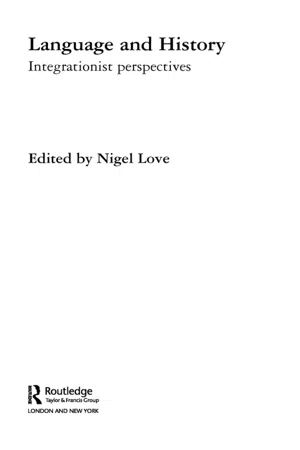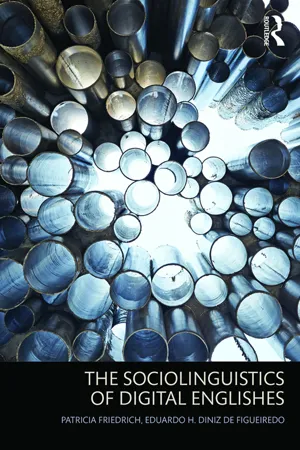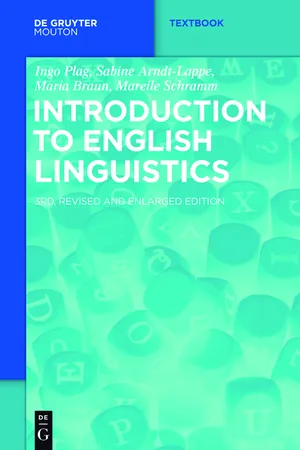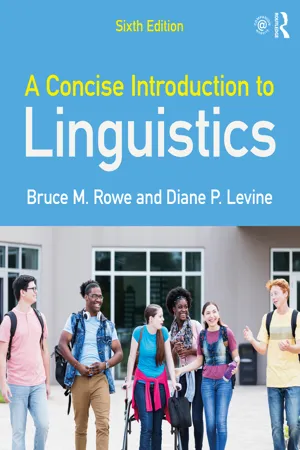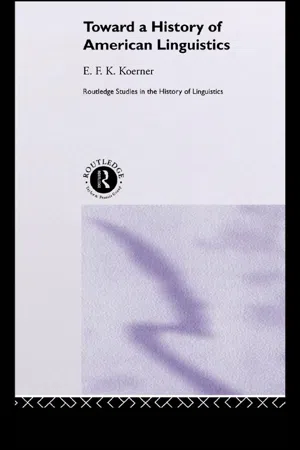Languages & Linguistics
History of English Language
The history of the English language traces its development from the early Germanic tribes who settled in Britain, through the influence of Latin and French, to its global spread and evolution into different dialects and variations. Key milestones include the Old English period, the Norman Conquest, the Great Vowel Shift, and the standardization of English through the printing press and dictionaries.
Written by Perlego with AI-assistance
Related key terms
Related key terms
1 of 4
Related key terms
1 of 3
8 Key excerpts on "History of English Language"
- eBook - ePub
Language and History
Integrationist Perspectives
- Nigel Love(Author)
- 2006(Publication Date)
- Routledge(Publisher)
Historical linguists, for their part, have in general never been particularly concerned to impose some special definition of their own, uniquely required for their historians’ purposes, 1 or to displace ordinary parlance by defining the term ‘a language’ so as to give unequivocal answers to questions about the boundary between one language and another (whether in time, in space, in terms of social stratification. . .), or to specify how exactly the concept of a dialect relates to the concept of a language, or to worry over whether the sense of ‘a language’ in which Spanish, say, is a form of Latin, should or should not take priority over the sense in which Spanish and Latin are different languages. Such issues have traditionally either not been thought to matter or else have been set aside sine die, or at any rate for a rainy one. In his chapter in this collection Roger Lass considers, from the perspective of a historical linguist working (albeit critically) within the orthodox scholarly tradition that starts with nineteenth-century comparative philology, some of the consequences for linguistic historiography of supposing that a language name like ‘English’ uncontroversially identifies a domain susceptible to historical treatment in terms of a linear narrative. English is especially problematic in this respect because of the relative wealth of documentary evidence available from different times and places, and because of the depth and intensity of study to which surviving texts have been subjected. A paradox emerges: the more that is known of a language’s history the less reason there is to suppose that it has one. Published histories of English are replete with statements to the effect that A ‘becomes’ B in cases where there is no reason to suppose, even granting the standard assumption that in certain circumstances the formula A > B has a coherent interpretation, 2 that A and B stand in any identifiable relationship of temporal succession - eBook - ePub
- Patricia Friedrich, Eduardo Diniz de Figueiredo(Authors)
- 2016(Publication Date)
- Routledge(Publisher)
Introduction Language, Englishes, and technology in perspectiveThis chapter will help you understand that:- Language use is a social activity, and humans are part of networks and speech communities.
- Englishes spread through several different waves of influence, including during the industrial revolution, in the post-World War II period, and with the development of the Internet.
- Linguistic change and technological advancement have often had a close historical connection.
- The Internet caused us to fuse oral and written modes of communication and thus adopt new norms and strategies for effective interaction.
- Dialects, both in the real world and the digital world, can be construed to be as large as a nation and as small as a person.
- The English language has spread so far that it has become both many Englishes and a global language.
- New communication technologies tend to bring about fears regarding the future of language.
- Questions about standard language are better addressed if we take into consideration issues of power and attitude; Internet standards are no exception.
Language: A prequel
The details surrounding the origin of human languages are much disputed in linguistic circles. We often joke that the absence of recording devices (and apps!) makes it very hard for us to indicate with any precision the exact moment humans started to engage in oral communication. Several researchers claim humans have used language for at least many thousands of years, while others date language as existing even earlier.The human capacity to produce language depends on both brain function and, in the case of oral communication, suitability of the speech apparatus , that is, the group of organs and structures involved in speech such as the mouth, the tongue, and the larynx with its attached vocal cords. Hence, not only does the brain need to be ready for language, but also the parts of the body involved in speech have to have certain characteristics to be able to produce the complex sounds of natural languages - eBook - ePub
The History of English
A Student's Guide
- Ishtia Singh(Author)
- 2013(Publication Date)
- Routledge(Publisher)
1
English as a Changing Language
1.1 Introduction
Chapter 3 begins our historical narrative of English in earnest, looking at the language in a series of snapshots which reveal something of the significant linguistic changes, as well as important socio-historical issues, which have characterized its existence at various points in its history. This approach is neither untried nor untested: texts such as Baugh and Cable (2002), Fennell (2001), Barber (1993), Strang (1970), to name but a few, have shown that this kind of historical (re-)construction effectively conveys both a general sense of linguistic change through time and a more specific awareness of significant changes at particular times. It is arguable, however, that this framework, in its inevitable representation of a language's history as a chronological series of discrete, significant ‘linguistic events’, does not wholly capture the dynamic and ongoing nature of linguistic change. For instance, discussions of lexical change which focus on the importance of compounding in Old English (OE), but on borrowing in Middle English (ME) and Early Modern English (EModE), obscure somewhat the continuous importance of both processes throughout all three periods. Similarly, a focus on inflectional change in OE and ME potentially marginalizes its ongoing significance in other periods, as well as creating the impression that it is the only notable dimension of morphosyntactic change. We will therefore attempt here to complement the period-based framework of later chapters by outlining some of the more common changes that have been (and continue to be) significant for English. There are, however, a few provisos to bear in mind before we begin. First, the following sections do not offer a comprehensive discussion of language change. Research in this area covers a great deal of ground: it is approached not only within different theoretical frameworks but also with differing (but related) questions in mind. Studies of language change can (and do) therefore address issues such as the differentiation between internally and externally motivated change (that is, change that occurs and proceeds because of factors either intrinsic to the language system or present in the external social context), or focus on determining the factors that actuate change in the first instance, and facilitate the transmission and retention of some features and the discarding of others. Change can also be measured sociolinguistically, in terms of variables such as age, gender and ethnicity, as well as of attitudes to it. All of these (plus others we have not mentioned) constitute huge areas of research and debate in themselves,1 and it is impossible to do them all justice in the space of this one chapter. We will therefore confine our discussion to major processes - eBook - ePub
- Ingo Plag, Sabine Arndt-Lappe, Maria Braun, Mareile Schramm(Authors)
- 2015(Publication Date)
- De Gruyter Mouton(Publisher)
7 Extensions and applications: historical linguistics, sociolinguistics and psycholinguistics
7.1 Introduction
In the preceding chapters you have encountered a host of language phenomena from various domains (phonetics, phonology, morphology, syntax, semantics, pragmatics), and you have learned how these phenomena can be investigated in order to find out more about the structure and use of language. Apart from these areas of linguistic research, scholars (and laypersons) are interested in many more questions concerning language and languages. In this chapter we will deal with three of such sets of questions. First, there are historical questions. How do languages develop and where do individual languages come from? What is the historical relationship between languages, e.g. between English and German? Why and how do languages change? Another set of questions concerns the social significance of language. Why is it that after listening to only a few words a speaker has uttered, we seem to know a lot about this speaker’s social background, for example her education, her social status, in which region she probably grew up, etc.? What exactly is it that is so telling? Third, many people are curious about how humans store and process language, and what language can reveal about our cognitive capacities in general.We will deal with each set of questions in turn, looking at important studies in these fields in an exemplary fashion. As you will notice, trying to meaningfully answer such questions necessitates a general understanding about how language ‘works’, i.e. what kinds of structural entities language consists of and how these entities interact with each other to create that highly complex system we call language. Having worked through the preceding chapters, you are now equipped with this kind of understanding. - eBook - ePub
- Claire Bowern, Bethwyn Evans, Claire Bowern, Bethwyn Evans(Authors)
- 2015(Publication Date)
- Routledge(Publisher)
section 5 ).We view historical linguistics as having three very different lines of inquiry. We can treat language change as a way to explore: (a) language and its structure; (b) human (pre)history; and (c) human cognition and psychology. Firstly, we can, of course, study language change on its own terms. Many handbooks of historical linguistics have focused on this, and the standard textbooks in historical linguistics (Campbell 2004; Crowley and Bowern 2010; Fox 1995; Hock and Joseph 1996; Ringe and Eska 2013; Trask 2003, among others) all devote much attention to the types of changes which we find in the different domains of language, often with little reference to external factors such as physiology, psychology, speaker biases, or social factors (see further section 3.3 ).Language also gives us insights into other areas of study. On the one hand, language is a tool for investigating the past . Just as past cultures have left traces in the archaeological record, we can recover parts of prehistory through current languages: through language distribution, through correspondences among related languages, through the study of loan words, and so on. In this case, language serves as a proxy for the populations who speak it. Epps3 makes this point in her discussion of the use of language in studying material culture, while Heggarty and Hale discuss some of the difficulties in treating language as a proxy for other aspects of human organisation.Language is also a tool for investigating the mind (Hruschka et al . 2009) and historical linguistics provides useful data here too. If linguistic organisation does indeed reflect more general cognitive processes (see Bybee and Beckner), then empirical data on language change can shed light not only on speakers’ linguistic behaviour, including aspects of language and language use that speakers pay attention to (cf. Maiden 2005), but also on other more general aspects of their cognitive behaviour. This can be seen, for example, in the types of constructions that are commonly grammaticised in language (Evans and Levinson 2009), and also in the kinds of constructions that are conservative (or stable) across time and space (see Wichmann - eBook - ePub
- Bruce M. Rowe, Diane P. Levine(Authors)
- 2022(Publication Date)
- Routledge(Publisher)
CHAPTER 14 Historical linguistics: the history of languagesDOI: 10.4324/9781003268369-14LEARNING OBJECTIVES- List and describe the main reasons that languages change over time.
- Identify the contributions of August Schleicher, Johannes Schmidt, and Sir William Jones to the study of historical linguistics.
- Define the terms language family and protolanguage.
- Describe how the comparative method is used to show relationships between languages and to reconstruct protolanguages.
- Compare the family tree model and the wave model of language relationship. Analyze the benefits and difficulties of each model in terms of their ability to explain historical linguistic phenomena.
- Explain what cognates are and provide examples.
- Explain the relatedness and regularity hypotheses.
- Define Grimm’s law.
- Explain the difference between conditioned and unconditioned phonological changes and provide examples of each type of change.
- List some examples of morphological changes and syntactic changes in language.
- Provide some examples of sociocultural and semantic changes in the English language.
- Discuss how sociocultural and semantic changes are related to each other.
- List and explain the ways linguists attempt to determine the rate at which daughter languages change from a mother language.
- Discuss the two main competing hypotheses on the location of the origin of Indo-European.
- When we speak of the spread of English throughout the world, it is more accurate to speak of the spread of “Englishes.” Analyze this statement.
All the elements of culture change over time. The political systems, economic systems, religion, kinship, and art are all modified by the passage of time; so is language. Culture change occurs for a variety of reasons. The movement of people spreads new ideas, values, beliefs, behaviors, and language. This movement might be due to peaceful trade and travel or invasion and warfare. Because people move around and take their language with them, languages that develop in one area can wind up being widely distributed. For instance, the spread of the British Empire distributed the English language throughout the world, starting at the beginning of the seventeenth century. By the end of World War I, the British had delivered the English language to about 25 percent of the world’s population. The entertainment industries in the United Kingdom and the United States as well as other media have continued to spread the English language throughout the world. - David Hornsby(Author)
- 2014(Publication Date)
- Teach Yourself(Publisher)
Language variation, for example, cannot be divorced from social factors such as class or regional origin with which it correlates. Part of speakers’ unconscious knowledge of their mother tongue is clearly of a social nature: English speakers, for example, can make informed judgements about a person’s regional origins or social background on the basis of his/her speech. The relationship between language and society is explored in the subdiscipline of sociolinguistics (see Chapters 11 and 12). Similarly, meaning cannot be properly understood in isolation from context and the knowledge shared by participants in an interaction, which form the subject matter of pragmatics (see Chapter 10). The emergent fields of psycholinguistics, neurolinguistics and biolinguistics all attest to the interaction of linguistic study with other fields of scientific enquiry, while the branch of linguistics known as stylistics uses theories of language to illuminate the study of literature. Classical and medieval linguistics Greek linguistic scholars were profoundly to influence their Latin successors, whose thinking, as we saw in Chapter 1, exerts a profound influence on prescriptive English grammar even today. The achievement that was to have the greatest impact on Europe and the wider world, however, was the development of a phonemic writing system, i.e. one based on the key sound contrasts used by the language. As early as the second millennium BCE, a syllabic writing system now known to archaeologists as ‘Linear B’ was used by the Myceneans, and in the first millennium BCE the first alphabet in the modern sense of the term was adapted by the Greeks from Phoenician script- eBook - ePub
- E.F.K. Koerner(Author)
- 2003(Publication Date)
- Routledge(Publisher)
If this assessment is accurate, it seems that, at least in North America, continued efforts to explain the usefulness of the subject may be required. My European colleagues, I know, feel that given the existence of three journals devoted to the subject and a few additional minor periodicals (bulletins, newsletters, etc.), monograph series, many specialized conferences, regional and international, and scholarly societies in many countries, there is no need to lobby for a place of the History of Linguistics within linguistics tout court any more. I would like to think that they are right. It remains interesting to note that subjects like the History of Medicine and the History of Science generally, for example, are flourishing subjects in North America; even the History of Psychology and the History of Philosophy are wellestablished subjects of research and university instruction. So one might well ask why the History of Linguistics has fared less well. Even if we put the beginning of linguistics as a science only as far back as 200 years, the study of language can boast a tradition as long as chemistry or biology. It is therefore curious to note that, whereas these natural (and some social) sciences have enjoyed the establishment of courses devoted to the history of their own discipline, no comparable arrangement exists with regard to linguistics. The science of language, a discipline in which the coexistence of diverging theoretical views and possibly contrasting methodological procedures, would, in my view, need a historical perspective more, not less, than, say, that modern medicine would be in need of history to guide its understanding of present-day health sciences. In view of this state of affairs regarding the History of Linguistics we may have to ask ourselves whether the work of historians of other disciplines has a sounder scientific basis, or how the apparent flourishing of the history of science may otherwise be explained
Index pages curate the most relevant extracts from our library of academic textbooks. They’ve been created using an in-house natural language model (NLM), each adding context and meaning to key research topics.
Explore more topic indexes
Explore more topic indexes
1 of 6
Explore more topic indexes
1 of 4
